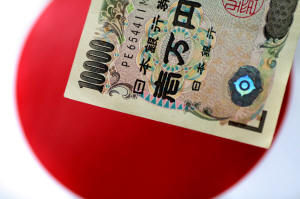Dollar steadies, yen holds near five-year low
 Send a link to a friend
Send a link to a friend
 [March 14, 2022] LONDON,
(Reuters) - The dollar slipped as European markets opened on Monday, but
was still near a five-year high versus Japan's yen as investors braced
for a busy week of major central bank meetings. [March 14, 2022] LONDON,
(Reuters) - The dollar slipped as European markets opened on Monday, but
was still near a five-year high versus Japan's yen as investors braced
for a busy week of major central bank meetings.
After uncertainty about the war in Ukraine prompted a market sell-off on
Friday, stock markets rebounded on Monday and commodity prices edged
back down.
Analysts attributed the revival of risk appetite to the fact that
Russian and Ukrainian negotiators hinted at progress in peace talks.
Currency markets were also driven by expectation that the U.S. Federal
Reserve will raise rates at its meeting this week, which ends on
Wednesday.
Investors were pricing in 93% chance of a 25 basis point hike.
Federal Reserve Chairman Jerome Powell last week flagged multiple
interest rate increases this year.
The dollar index rose during Asian trading, coming close to a 22-month
high as the rate-sensitive short term U.S. Treasury yields rose, but it
then edged lower as European markets opened.
At 0857 GMT, the dollar index was down 0.1% on the day at 98.886.

"We know at this point the Fed is hyper focused on inflation so we
expect Powell will continue to weigh that challenge over the conflict in
the Ukraine," said Adam Cole, chief currency strategist at RBC, in a
note to clients.
The U.S. dollar hit a five-year high against the Japanese yen overnight,
at 117.88, as investors bet that the Bank of Japan, which meets on
Friday, would maintain its dovish stance despite rising inflationary
pressures.
"USD/JPY continues to press higher driven by both higher US yields and
the fallout of the fossil fuel surge on Japan's trade balance," wrote
ING FX strategists in a note to clients.
[to top of second column] |

A Japan yen note is seen in this illustration photo taken June 1,
2017. REUTERS/Thomas White/Illustration

At 0900 GMT, the pair had eased to 117.775.
The British pound was still near a 16-month low, flat on the day at $1.30415,
ahead of the Bank of England meeting on Thursday.
The euro was up 0.5% at $1.0953.
The Australian dollar was down 0.6%, hurt by the easing of commodity prices,
while the New Zealand dollar was down 0.2%.
Lockdown measures to limit the spread of COVID-19 in China saw the yuan weaken.
The dollar hit 6.382 versus the offshore yuan, the yuan's weakest in more than a
month.
China has reported more local symptomatic COVID-19 cases so far this year than
it recorded in all of 2021, as the highly transmissible Omicron variant triggers
outbreaks from Shanghai to Shenzhen.
"The Chinese yuan has started to feel the weakening pressure due to continuous
bad news for the economy," wrote Commerzbank senior economist Hao Zhou in a
client note.
"China is also facing intensifying pressure from the West to clarify its stance
on the Ukraine war."
(Reporting by Elizabeth Howcroft; Editing by Raissa Kasolowsky)
[© 2022 Thomson Reuters. All rights
reserved.]This material may not be published,
broadcast, rewritten or redistributed.
Thompson Reuters is solely responsible for this content. |